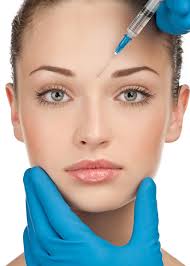The availability of cosmetic procedures to enhance our appearance seems to be ever-increasing. I was surprised to discover recently that even my local gym will offer Botox, a chemical peel or lip fillers if you are in the market for more than just a workout. Similarly, when I was looking for a new dentist, I was struck by the fact that most practices in my local area were promoting teeth whitening and veneers as opposed to oral hygiene and dental health.
Data from The American Society for Aesthetic Plastic Surgery shows that a staggering $13.5 billion was spent in 2015 in the US on surgical and non-surgical cosmetic treatments1. Over the last five years, there has been a 17% rise in surgical procedures in the US1. Even more strikingly, non-surgical procedures have increased by 44%, with Botox leading the pack1. Similarly, figures from The British Association of Aesthetic Plastic Surgeons show that 2015 was a bumper year for cosmetic surgery in the UK, with a 13% increase compared to 20142.

In light of this growing trend in cosmetic treatments, an important but overlooked question is: what is the impact on mental health? An optimist might say that such procedures are empowering and enable individuals to improve their body confidence, self-esteem and psychological wellbeing. In some cases this may well be true. We probably all know of people who have undergone a cosmetic procedure and seemed genuinely happy with the outcome. Nevertheless, there is a concern that such an emphasis on cosmetic treatments may implicitly be fuelling the societal importance that is placed on appearance, which is likely to have negative ramifications for at least some individuals.
One group for whom cosmetic procedures may be concerning is those with body dysmorphic disorder (BDD). BDD is a disabling psychiatric condition affecting approximately 2% of young people3,4 and adults5,6. It is characterised by excessive preoccupation with perceived flaws or defects in appearance, which cause substantial distress and/or impairment7. These flaws are unobservable or appear minimal to others. For example, a sufferer may be spend hours every day worrying that their nose is crooked, when in fact it appears normal to others. Individuals with BDD vary in the level of conviction with which they hold their beliefs; some sufferers may acknowledge that their worry is excessive while others are convinced that there is something significantly physically wrong with their appearance. It is not surprising therefore that BDD sufferers commonly turn to cosmetic procedures in a desperate attempt to alleviate their distress. More specifically, it is estimated that about three-quarters of adults and almost half of young people with BDD seek surgical and no n-surgical cosmetic treatments8,9. These individuals are not striving for perfection in their appearance, but rather they are seeking to correct their perceived defect in an attempt to blend in with the crowd. As one patient said to me, she wanted to move along an imaginary appearance continuum from “hideous” to “normal”, not from “normal” to “beautiful”.
n-surgical cosmetic treatments8,9. These individuals are not striving for perfection in their appearance, but rather they are seeking to correct their perceived defect in an attempt to blend in with the crowd. As one patient said to me, she wanted to move along an imaginary appearance continuum from “hideous” to “normal”, not from “normal” to “beautiful”.
“These individuals are not striving for perfection in their appearance, but rather they are seeking to correct their perceived defect in an attempt to blend in with the crowd.”
So what is the problem, you might ask? Maybe altering and enhancing their appearance could help individuals with BDD to feel more confident, even happy? Results of a recent systematic review on cosmetic procedures in BDD, led by Dr Laura Bowyer10, cast doubt on this view. Of the 11 studies included in the r eview, 8 found poor outcomes in individuals with BDD following cosmetic procedures. Typically, these studies found that, for the vast majority of individuals, BDD symptoms remained unchanged or even worsened following cosmetic treatments. Patients frequently reported that they had developed new appearance concerns, were continuing to worry about the treated area and/or were worrying that an improved body part would become “ugly” again. Only three studies were identified as having found positive outcomes following cosmetic procedures. While these raise some interesting questions for future research, the studies themselves were found to be methodologically limited.
eview, 8 found poor outcomes in individuals with BDD following cosmetic procedures. Typically, these studies found that, for the vast majority of individuals, BDD symptoms remained unchanged or even worsened following cosmetic treatments. Patients frequently reported that they had developed new appearance concerns, were continuing to worry about the treated area and/or were worrying that an improved body part would become “ugly” again. Only three studies were identified as having found positive outcomes following cosmetic procedures. While these raise some interesting questions for future research, the studies themselves were found to be methodologically limited.
“Patients with BDD who seek cosmetic procedures are essentially looking for a physical solution to a psychological problem.”
In summary, the systematic review concludes that the weight of evidence to date suggests that cosmetic treatments are likely to be ineffective or counterproductive for the majority of individuals with BDD. From a clinical perspective, this makes sense. Patients with BDD who seek cosmetic procedures are essentially looking for a physical solution to a psychological problem. It is analogous to a patient with obsessive-compulsive disorder trying to allay their worries about contamination by cleaning; rather than solving their problem it is going to fuel it. However, the review also outlines the significant limitations of research to date and the need for further, methodologically rigorous research. At time when cosmetic treatments are so easily accessible, such studies are urgently required in order to inform the development of evidence-based clinical guidelines for cosmetic treatment in BDD.
References:
- American Society for Aesthetic Plastic Surgery (ASAPS) (2015). Cosmetic surgery National Data Bank Statistics. http://www.surgery.org/sites/default/files/ASAPS-Stats2015.pdf
- British Association of Aesthetic Plastic Surgeons (BAAPS) (2016). ‘Daddy Makeovers’ and Celeb Confessions: Cosmetic Surgery Procedures Soar in Britain. http://baaps.org.uk/about-us/press-releases/2202-super-cuts-daddy-makeovers-and-celeb-confessions-cosmetic-surgery-procedures-soar-in-britain
- Rief W, Buhlmann U, Wilhelm S, et al. (2006) The prevalence of body dysmorphic disorder: a population-based survey. Psychological Medicine, 36: 877–885.
- Schneider, S. C., Turner, C. M., Mond, J., & Hudson, J. L. (in press). Prevalence and correlates of body dysmorphic disorder in a community sample of adolescents. Australian and New Zealand Journal of Psychiatry.
- Buhlmann U, Glaesmer H, Mewes R, et al. (2010). Updates on the prevalence of body dysmorphic disorder: A population-based survey. Psychiatry Research 178: 171–175.
- Koran LM, Aboujaoude E, Large MD, et al. (2008). The prevalence of body dysmorphic disorder in the United States adult population. CNS Spectrums 13: 316–322.
- American Psychiatric Association (APA) (2013). Diagnostic and Statistical Manual of Mental Disorders. Arlington, VA: American Psychiatric Publishing.
- Phillips, K. A., Grant, J. E., Siniscalchi, J., et al. (2001). Surgical and nonpsychiatric medical treatment of patients with body dysmorphic disorder. Psychosomatics, 42: 504,
- Crerand, C. E., Phillips, K. A., Menard, W., et al. (2005). Non-psychiatric medical treatment of body dysmorphic disorder. Psychosomatics, 46: 549.
- Bowyer, L., Krebs, G., Mataix-Cols, D., Veale, D., & Monzani, B. (2016). A critical review of cosmetic treatment outcomes in body dysmorphic disorder. Body Image, 19: 1-8.

